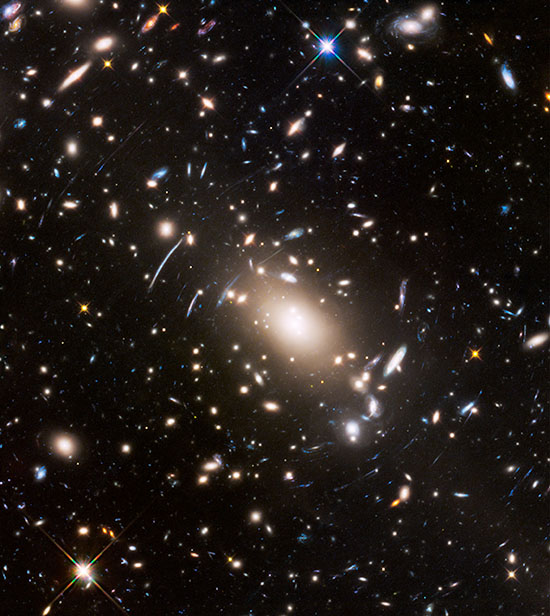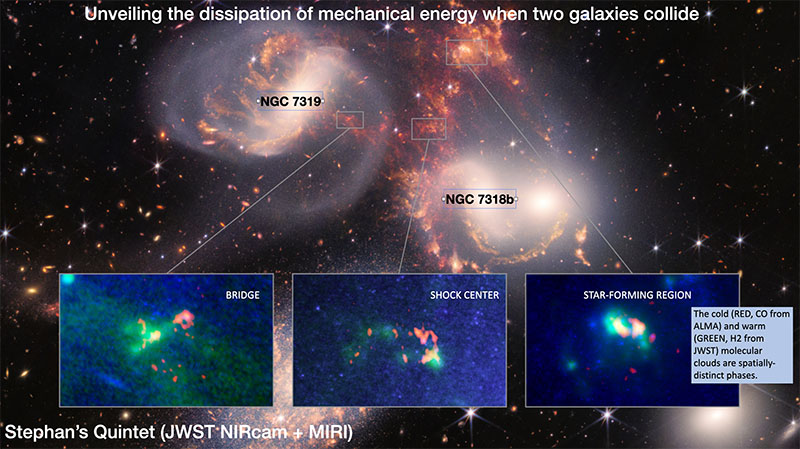FROM PRIMORDIAL GALAXIES TO STEPHAN'S QUINTET WITH JAMES WEBB SPACE TELESCOPE
Two observing programs with the new James Webb Space Telescope (JWST), led by IAP researchers, have been awarded as part of the 2nd observing cycle. The first is one of the largest with 148 hours of observation of the primordial galaxies of the Universe with the NIRCam instrument. The goal of this program is to understand the conditions that favor and those that prevent the formation of the first galaxies. The second observation program will observe Stephan's Quintet, a group of interacting galaxies, for 23 hours with the MIRI instrument. The objective of this program is to elucidate why this merger of galaxies does not trigger a burst of star formation, as one might expect.
 Figure 1 : The Abell S1063 cluster of galaxies observed by the Hubble space telescope in the framework of the “Frontier Fields” programme.
Figure 1 : The Abell S1063 cluster of galaxies observed by the Hubble space telescope in the framework of the “Frontier Fields” programme.
Credit: NASA, ESA, and J. Lotz (STScI)
The “JWST's GLIMPSE: gravitational lensing & NIRCam imaging to probe early galaxy formation and sources of reionization” programme, led by Hakim Atek of the Institut d’astrophysique de Paris, benefited from 148 heures of observating time with the NIRCam camera of the James Webb space telescope (JWST), in order to obtain the deepest observations of the sky ever made. It is the cluster of galaxies Abell S1063 (see Figure 1), located at a distance of 4.5 billion light-years from the Milky Way, which will be scrutinized. The gravitational lensing effect of this huge mass concentration will be used to amplify the light from distant background galaxies: the cluster acts as a cosmic magnifying glass and makes more distant galaxies in the background of the cluster brighter, so that they become visible. Some images are heavily distorted by gravitational lensing and appear as arcs (see Figure 1). The astronomers of the GLIMPSE collaboration will search for the first galaxies formed in the Universe a few hundred million years after the Big Bang, and a thousand times less luminous than the Milky Way (called “primordial” galaxies). Their objective is to better understand the mechanisms of formation and evolution of primordial galaxies, as well as their role during the so-called “reionization” period, during which almost all of the neutral hydrogen which filled the Universe has been ionized by objects yet to be determined. The observations of the GLIMPSE program will take place over a period of approximately one year from September 2023. The collaboration of the program consists of Iryna Chemerynska, PhD student at the IAP, Lukas Furtak, former PhD student at the IAP (currently in Israël), researchers from the Centre de Recherche Astrophysique de Lyon, as well as researchers from laboratories in Switzerland, Denmark, and the United States of America.
The “Shaken and stirred” programme, led by Philip Appleton (Califormia Institute of Technology, Pasadena, CA), and co-led by Pierre Guillard of the Institut d'Astrophysique de Paris and Bjorn Emonts (National Radio Astronomy Observatory, Charlottesville, Virginia), will benefit from 23 hours of observations with the integral field spectrograph of the MIRI instrument aboard the James Webb Space Telescope (JWST), in order to observe a group of galaxies, the "Stephan's Quintet", located at a distance of 270 million light years from the Milky Way. In this group, two galaxies are colliding at high speed (several hundred kilometers per second), which will eventually lead to their merger into a single galaxy. The mechanical energy of this collision induces a multitude of shocks in the gaseous medium located between the galaxies. This medium is heterogeneous, made up of very diffuse gas undergoing shocks at high speed and at very high temperatures (several million degrees), but also of denser hydrogen gas, subjected to shocks at lower speeds, which can then cool under the effect of compression (to about -100 degrees Celcius) and form large quantities of the dihydrogen molecule, H2 (see Figure 2). Unexpectedly, very few stars form in the shock region, whereas in general galaxy mergers trigger bursts of star formation from cold molecular gas. It is probably the turbulent[1] motion of the gas and the large dynamic and thermal variations that this induces, that prevents the gas from forming stars. The objective of this observation program is to understand how large amounts of molecular gas, but few stars, can form in a gaseous medium undergoing a high-velocity shock. Observing with the MIRI instrument six regions identified as turbulent will allow researchers to precisely determine the mass, temperature, and overall motions of molecular gas in these regions (see Figure 2). The collaboration is made up of researchers from the Ecole Normale Supérieure and the Observatoire Astronomique de Strasbourg, as well as researchers from laboratories in Spain, Canada and the United States of America.
Note
[1] Turbulence is characterized by strong variations in intensity and direction of the velocity measured at any point of a fluid, leading to a highly disordered appearance at many spatial and temporal scales.

Figure 2 : The center of Stephan's Quintet group of galaxies observed with the MIRI and NIRCam cameras of JWST. The galaxies NGC 7319 and NGC 7318b are in the process of merging, creating a shock in the intergalactic medium. We see between these two galaxies, in red, the emission of the H2 dihydrogen molecule. The inserts (bottom) show three of the six regions that will be observed with the MIRI instrument of JWST in order to measure the dynamics of this gas and its temperature. Credits: NASA, ESA, and P. Guillard (IAP) |
Information on observing programmes:
![]() Programme “Shaken and stirred”
Programme “Shaken and stirred”
Links
Writing and contacts
- Hakim Atek
Institut d’astrophysique de Paris, CNRS, Sorbonne Université
hakim [dot] atek [at] iap [dot] fr - Pierre Guillard
Institut d’astrophysique de Paris, CNRS, Sorbonne Université
pierre [dot] guillard [at] iap [dot] fr
Web writing: Valérie de Lapparent
Layout: Jean Mouette
June 2023
